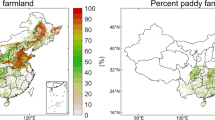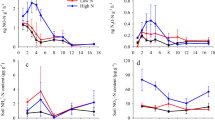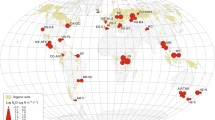Abstract
Precipitation and nitrogen (N) fertilization are the two most important drivers for soil nitrous oxide (N2O) emission. However, the effects of changes in N fertilization and precipitation patterns (i.e., precipitation intensity and frequency) on N2O emissions in agricultural fields are still unclear. In this study, we simulated soil N2O emission under different precipitation patterns (6 precipitation intensities, and 12 precipitation frequencies by either merging or splitting precipitation events) and N fertilization rates (low, typical, and high N fertilization) in a cornfield using the DeNitrification-DeComposition model. The model was parameterized and validated using meteorological data and N experimental measurements in Nashville, Tennessee, USA. Results showed that soil water filled pore space (WFPS) and simulated soil N2O emission increased as precipitation intensity increased. Less frequent but high intensity precipitation treatments reduced the soil WFPS by 25.2% and stimulated soil N2O emission by 45.3%, while more frequent but low intensity precipitation treatments increased soil WFPS by 9.0% and reduced soil N2O emission by 23.9%. Compared to typical N fertilization, the sensitivity of soil N2O emission to precipitation was higher under high N than low N fertilization treatments, and the response ratios were 50.0% and 40.1%, respectively. There was significant interactive effect of precipitation intensity and N fertilization on soil N2O emission. These findings improved our understanding of precipitation and N impacts on soil N2O emissions and provided useful knowledge for irrigation and N fertilizer management in agriculture to mitigate greenhouse gas emissions.






Similar content being viewed by others
References
Albanito F, Lebender U, Cornulier T, Sapkota TB, Brentrup F, Stirling C, Hillier J (2017) Direct nitrous oxide emissions from tropical and sub-tropical agricultural systems-a review and modelling of emission factors. Sci Rep 7:44235. https://doi.org/10.1038/srep44235
Aronson EL, Goulden ML, Allison SD (2019) Greenhouse gas fluxes under drought and nitrogen addition in a Southern California grassland. Soil Biol Biochem 131:19–27. https://doi.org/10.1016/j.soilbio.2018.12.010
Attard E, Recous S, Chabbi A, De Berranger C, Guillaumaud N, Labreuche J, Philippot L, Schmid B, Le Roux X (2011) Soil environmental conditions rather than denitrifier abundance and diversity drive potential denitrification after changes in land uses. Global Change Biol 17:1975–1989. https://doi.org/10.1111/j.1365-2486.2010.02340.x
Austin AT, Yahdjian L, Stark JM, Belnap J, Porporato A, Norton U, Ravetta DA, Schaeffer SM (2004) Water pulses and biogeochemical cycles in arid and semiarid ecosystems. Oecologia 141:221–235. https://doi.org/10.1007/s00442-004-1519-1
Beier C, Beierkuhnlein C, Wohlgemuth T, Penuelas J, Emmett B, Körner C, de Boeck H, Christensen JH, Leuzinger S, Janssens IA, Hansen K (2012) Precipitation manipulation experiments - challenges and recommendations for the future. Ecol Lett 15:899–911. https://doi.org/10.1111/j.1461-0248.2012.01793.x
Bollmann A, Conrad R (1998) Influence of O2 availability on NO and N2O release by nitrification and denitrification in soils. Global Change Biol 4:387–396. https://doi.org/10.1046/j.1365-2486.1998.00161.x
Borken W, Matzner E (2009) Reappraisal of drying and wetting effects on C and N mineralization and fluxes in soils. Global Change Biol 15:808–824. https://doi.org/10.1111/j.1365-2486.2008.01681.x
Bouwman AF, Boumans LJM, Batjes NH (2002) Emissions of N2O and NO from fertilized fields: summary of available measurement data. Global Biogeochem Cycles. https://doi.org/10.1029/2001gb001811
Bremner JM (1997) Sources of nitrous oxide in soils. Nutr Cycl Agroecosyst 49:7–16. https://doi.org/10.1023/a:1009798022569
Brown JR, Blankinship JC, Niboyet A, van Groenigen KJ, Dijkstra P, Le Roux X, Leadley PW, Hungate BA (2012) Effects of multiple global change treatments on soil N2O fluxes. Biogeochemistry 109:85–100. https://doi.org/10.1007/s10533-011-9655-2
Butterbach-Bahl K, Baggs EM, Dannenmann M, Kiese R, Zechmeister-Boltenstern S (2013) Nitrous oxide emissions from soils: how well do we understand the processes and their controls? Philos Trans R Soc B Biol Sci. https://doi.org/10.1098/rstb.2013.0122
Butterly CR, McNeill AM, Baldock JA, Marschner P (2011) Rapid changes in carbon and phosphorus after rewetting of dry soil. Biol Fertility Soils 47:41–50. https://doi.org/10.1007/s00374-010-0500-x
Charles A, Rochette P, Whalen JK, Angers DA, Chantigny MH, Bertrand N (2017) Global nitrous oxide emission factors from agricultural soils after addition of organic amendments: A meta-analysis. Agric Ecosyst Environ 236:88–98. https://doi.org/10.1016/j.agee.2016.11.021
Chen W, Zheng X, Chen Q, Wolf B, Butterbach-Bahl K, Brueggemann N, Lin S (2013) Effects of increasing precipitation and nitrogen deposition on CH4 and N2O fluxes and ecosystem respiration in a degraded steppe in Inner Mongolia, China. Geoderma 192:335–340. https://doi.org/10.1016/j.geoderma.2012.08.018
Chen H, Li L, Luo X, Li Y, Liu D, Zhao Y, Feng H, Deng J (2019) Modeling impacts of mulching and climate change on crop production and N2O emission in the Loess Plateau of China. Agric for Meteorol 268:86–97. https://doi.org/10.1016/j.agrformet.2019.01.002
Dalal RC, Wang WJ, Robertson GP, Parton WJ (2003) Nitrous oxide emission from Australian agricultural lands and mitigation options: a review. Aust J Soil Res 41:165–195. https://doi.org/10.1071/sr02064
Denef K, Six J, Paustian K, Merckx R (2001) Importance of macroaggregate dynamics in controlling soil carbon stabilization: short-term effects of physical disturbance induced by dry–wet cycles. Soil Biol Biochem 33:2145–2153. https://doi.org/10.1016/S0038-0717(01)00153-5
Deng Q, Hui D, Wang J, Lwuozo S, Yu C, Jima T, Smart D, Reddy C, Dennis S (2015) Corn yield and soil nitrous oxide emission under different fertilizer and soil management: a three-year field experiment in middle tennessee. PLoS ONE. https://doi.org/10.1371/journal.pone.0125406
Deng Q, Hui D, Wang J, Yu CL, Li C, Reddy KC, Dennis S (2016) Assessing the impacts of tillage and fertilization management on nitrous oxide emissions in a cornfield using the DNDC model. J Geophys Res-Biogeosci 121:337–349. https://doi.org/10.1002/2015jg003239
Deng J, Guo L, Salas W, Ingraham P, Charrier-Klobas JG, Frolking S, Li C (2018) Changes in irrigation practices likely mitigate nitrous oxide emissions from California cropland. Global Biogeochem Cycles 32:1514–1527. https://doi.org/10.1029/2018gb005961
Deng L, Huang C, Dong-Gill K, Shangguan Z, Wang K, Song X, Peng C (2019) Soil GHG fluxes are altered by N deposition: New data indicate lower N stimulation of the N2O flux and greater stimulation of the calculated C pools. Global Change Biol. https://doi.org/10.1111/gcb.14970
Dobbie KE, Smith KA (2003) Nitrous oxide emission factors for agricultural soils in Great Britain: the impact of soil water-filled pore space and other controlling variables. Global Change Biol 9:204–218. https://doi.org/10.1046/j.1365-2486.2003.00563.x
Fageria NK, Baligar VC (2005) Enhancing nitrogen use efficiency in crop plants. In: Sparks DL (ed) Advances in Agronomy, vol 88. Elsevier Academic Press Inc, San Diego, USA, pp 97–185. https://doi.org/10.1016/S0065-2113(05)88004-6
Fentabil MM, Nichol CF, Jones MD, Neilsen GH, Neilsen D, Hannam KD (2016) Effect of drip irrigation frequency, nitrogen rate and mulching on nitrous oxide emissions in a semi-arid climate: An assessment across two years in an apple orchard. Agric Ecosyst Environ 235:242–252. https://doi.org/10.1016/j.agee.2016.09.033
Fierer N, Schimel JP (2002) Effects of drying-rewetting frequency on soil carbon and nitrogen transformations. Soil Biol Biochem 34:777–787. https://doi.org/10.1016/s0038-0717(02)00007-x
Foltz ME, Zilles JL, Koloutsou-Vakakis S (2019) Prediction of N2O emissions under different field management practices and climate conditions. Sci Total Environ 646:872–879. https://doi.org/10.1016/j.scitotenv.2018.07.364
Giltrap DL, Li C, Saggar S (2010) DNDC: a process-based model of greenhouse gas fluxes from agricultural soils. Agric Ecosyst Environ 136:292–300. https://doi.org/10.1016/j.agee.2009.06.014
Huang H, Wang J, Hui D, Miller DR, Bhattarai S, Dennis S, Smart D, Sammis T, Reddy KC (2014) Nitrous oxide emissions from a commercial cornfield (Zea mays) measured using the eddy covariance technique. Atmos Chem Phys 14:12839–12854. https://doi.org/10.5194/acp-14-12839-2014
Ingraham PA, Salas WA (2019) Assessing nitrous oxide and nitrate leaching mitigation potential in US corn crop systems using the DNDC model. Agric Syst 175:79–87. https://doi.org/10.1016/j.agsy.2019.05.005
IPCC (2014) Climate change 2014: Synthesis report. Contribution of working groups I, II and III to the fifth assessment report of the intergovernmental panel on climate Change [Core Writing Team, R.K. Pachauri and L.A. Meyer (eds.)] Geneva, Switzerland, p 151
Kim D-G, Hernandez-Ramirez G, Giltrap D (2013) Linear and nonlinear dependency of direct nitrous oxide emissions on fertilizer nitrogen input: a meta-analysis. Agric Ecosyst Environ 168:53–65. https://doi.org/10.1016/j.agee.2012.02.021
Knapp AK, Hoover DL, Wilcox KR, Avolio ML, Koerner SE, La Pierre KJ, Loik ME, Luo YQ, Sala OE, Smith MD (2015) Characterizing differences in precipitation regimes of extreme wet and dry years: implications for climate change experiments. Global Change Biol 21:2624–2633. https://doi.org/10.1111/gcb.12888
Knutson TR, Tuleya RE (2004) Impact of CO2-induced warming on simulated hurricane intensity and precipitation: sensitivity to the choice of climate model and convective parameterization. J Clim 17:3477–3495. https://doi.org/10.1175/1520-0442(2004)017%3c3477:iocwos%3e2.0.co;2
Li C, Frolking S, Frolking TA (1992a) A model of nitrous oxide evolution from soil driven by rainfall events: 1. Model structure and sensitivity. J Geophys Res Atmospheres 97:9759–9776. https://doi.org/10.1029/92jd00509
Li C, Frolking S, Frolking TA (1992b) A model of nitrous oxide evolution from soil driven by rainfall events: 2. Model applications. J Geophys Res Atmospheres 97:9777–9783. https://doi.org/10.1029/92jd00510
Li L, Zheng Z, Biederman JA, Xu C, Xu Z, Che R, Wang Y, Cui X, Hao Y (2019a) Ecological responses to heavy rainfall depend on seasonal timing and multi-year recurrence. New Phytol 223:647–660. https://doi.org/10.1111/nph.15832
Li L, Zheng Z, Wang W, Biederman JA, Xu X, Ran Q, Quan R, Xu C, Zhang B, Wang F, Zhou S, Cui L, Che R, Hao Y, Cui X, Xu Z, Wang Y (2019b) Terrestrial N2O emissions and related functional genes under climate change: a global meta-analysis. Global Change Biol. https://doi.org/10.1111/gcb.14847
Liang J, Qi X, Souza L, Luo Y (2016) Processes regulating progressive nitrogen limitation under elevated carbon dioxide: a meta-analysis. Biogeosciences 13:2689–2699. https://doi.org/10.5194/bg-13-2689-2016
Liu C, Wang K, Meng S, Zheng X, Zhou Z, Han S, Chen D, Yang Z (2011) Effects of irrigation, fertilization and crop straw management on nitrous oxide and nitric oxide emissions from a wheat-maize rotation field in northern China. Agric Ecosyst Environ 140:226–233. https://doi.org/10.1016/j.agee.2010.12.009
Lopez-Sangil L, Hartley IP, Rovira P, Casals P, Sayer EJ (2018) Drying and rewetting conditions differentially affect the mineralization of fresh plant litter and extant soil organic matter. Soil Biol Biochem 124:81–89. https://doi.org/10.1016/j.soilbio.2018.06.001
Mathieu O, Henault C, Leveque J, Baujard E, Milloux MJ, Andreux F (2006) Quantifying the contribution of nitrification and denitrification to the nitrous oxide flux using N-15 tracers. Environ Pollut 144:933–940. https://doi.org/10.1016/j.envpol.2006.02.005
NCGA (2019) World of Corn 2019. https://doi.org/worldofcorn.com/pdf/WOC-2019.pdf. Accessed 1 Dec 2019
Ni X, Liao S, Wu F, Groffman PM (2019) Short-term precipitation pulses stimulate soil CO2 emission but do not alter CH4 and N2O fluxes in a northern hardwood forest. Soil Biol Biochem 130:8–11. https://doi.org/10.1016/j.soilbio.2018.11.021
Ning D, Qin A, Duan A, Xiao J, Zhang J, Liu Z, Liu Z, Zhang B, Liu Z (2019) Deficit irrigation combined with reduced N-fertilizer rate can mitigate the high nitrous oxide emissions from Chinese drip-fertigated maize field. Glob Ecol Conserv. https://doi.org/10.1016/j.gecco.2019.e00803
NOAA (2018) Trends in atmospheric nitrous oxide. Global monitoring laboratory. NOAA’s Earth System Research Laboratories. https://www.esrl.noaa.gov/gmd/ccgg/trends_n2o/.Accessed 1 Dec 2019
Reay DS, Davidson EA, Smith KA, Smith P, Melillo JM, Dentener F, Crutzen PJ (2012) Global agriculture and nitrous oxide emissions. Nat Climate Change 2:410–416. https://doi.org/10.1038/nclimate1458
Reichstein M, Bahn M, Ciais P, Frank D, Mahecha MD, Seneviratne SI, Zscheischler J, Beer C, Buchmann N, Frank DC, Papale D, Rammig A, Smith P, Thonicke K, van der Velde M, Vicca S, Walz A, Wattenbach M (2013) Climate extremes and the carbon cycle. Nature 500:287–295. https://doi.org/10.1038/nature12350
Rillig MC, Ryo M, Lehmann A, Aguilar-Trigueros CA, Buchert S, Wulf A, Iwasaki A, Roy J, Yang G (2019) The role of multiple global change factors in driving soil functions and microbial biodiversity. Science 366:886–890. https://doi.org/10.1126/science.aay2832
Rochette P, Tremblay N, Fallon E, Angers DA, Chantigny MH, MacDonald JD, Bertrand N, Parent LÉ (2010) N2O emissions from an irrigated and non-irrigated organic soil in eastern Canada as influenced by N fertilizer addition. Eur J Soil Sci 61:186–196. https://doi.org/10.1111/j.1365-2389.2009.01222.x
Shcherbak I, Millar N, Robertson GP (2014) Global metaanalysis of the nonlinear response of soil nitrous oxide (N2O) emissions to fertilizer nitrogen. Proc Natl Acad Sci USA 111:9199–9204. https://doi.org/10.1073/pnas.1322434111
Taft HE, Cross PA, Hastings A, Yeluripati J, Jones DL (2019) Estimating greenhouse gases emissions from horticultural peat soils using a DNDC modelling approach. J Environ Manag 233:681–694. https://doi.org/10.1016/j.jenvman.2018.11.113
Tian H, Lu C, Ciais P, Michalak AM, Canadell JG, Saikawa E, Huntzinger DN, Gurney KR, Sitch S, Zhang B, Yang J, Bousquet P, Bruhwiler L, Chen G, Dlugokencky E, Friedlingstein P, Melillo J, Pan S, Poulter B, Prinn R, Saunois M, Schwalm CR, Wofsy SC (2016) The terrestrial biosphere as a net source of greenhouse gases to the atmosphere. Nature 531:225–228. https://doi.org/10.1038/nature16946
Tian D, Zhang YY, Mu YJ, Zhou YZ, Zhang CL, Liu JF (2017) The effect of drip irrigation and drip fertigation on N2O and NO emissions, water saving and grain yields in a maize field in the North China. Plain Sci Total Environ 575:1034–1040. https://doi.org/10.1016/j.scitotenv.2016.09.166
Tian H, Xu R, Canadell JG, Thompson RL, Winiwarter W, Suntharalingam P, Davidson EA, Ciais P, Jackson RB, Janssens-Maenhout G, Prather MJ (2020) A comprehensive quantification of global nitrous oxide sources and sinks. Nature 586(7828):248–256
Volpi I, Ragaglini G, Di Nasso NNO, Bonari E, Bosco S (2019) Soil N2O emissions in Mediterranean arable crops as affected by reduced tillage and N rate. Nutrient Cycl Agroecosyst. https://doi.org/10.1007/s10705-019-10032-1
Wang J, Chadwick DR, Cheng Y, Yan X (2018) Global analysis of agricultural soil denitrification in response to fertilizer nitrogen. Sci Total Environ 616:908–917. https://doi.org/10.1016/j.scitotenv.2017.10.229
Wolf I, Russow R (2000) Different pathways of formation of N2O, N2 and NO in black earth soil. Soil Biol Biochem 32:229–239. https://doi.org/10.1016/s0038-0717(99)00151-0
Wrage N, Velthof GL, van Beusichem ML, Oenema O (2001) Role of nitrifier denitrification in the production of nitrous oxide. Soil Biol Biochem 33:1723–1732. https://doi.org/10.1016/s0038-0717(01)00096-7
Wu Z, Dijkstra P, Koch GW, Penuelas J, Hungate BA (2011) Responses of terrestrial ecosystems to temperature and precipitation change: a meta-analysis of experimental manipulation. Global Change Biol 17:927–942. https://doi.org/10.1111/j.1365-2486.2010.02302.x
Xiang SR, Doyle A, Holden PA, Schimel JP (2008) Drying and rewetting effects on C and N mineralization and microbial activity in surface and subsurface California grassland soils. Soil Biol Biochem 40:2281–2289. https://doi.org/10.1016/j.soilbio.2008.05.004
Xu R, Wang Y, Wang Y, Niu H, Liu Y, Zhuang Q (2019) Estimating N2O emissions from soils under natural vegetation in China. Plant Soil 434:271–287. https://doi.org/10.1007/s11104-018-3856-6
Yan G, Mu C, Xing Y, Wang Q (2018) Responses and mechanisms of soil greenhouse gas fluxes to changes in precipitation intensity and duration: a meta-analysis for a global perspective Can. J Soil Sci 98:591–603. https://doi.org/10.1139/cjss-2018-0002
Yue Q, Cheng K, Ogle S, Hillier J, Smith P, Abdalla M, Ledo A, Sun J, Pan G (2019) Evaluation of four modelling approaches to estimate nitrous oxide emissions in China’s cropland. Sci Total Environ 652:1279–1289. https://doi.org/10.1016/j.scitotenv.2018.10.336
Zhan W, He XG, Sheffield J, Wood EF (2020) Projected seasonal changes in large-scale global precipitation and temperature extremes based on the CMIP5 ensemble. J Clim 33:5651–5671. https://doi.org/10.1175/jcli-d-19-0311.1
Zhang Y, Niu H, Wang S, Xu K, Wang R (2016) Application of the DNDC model to estimate N2O emissions under different types of irrigation in vineyards in Ningxia, China. Agric Water Manage 163:295–304. https://doi.org/10.1016/j.agwat.2015.10.006
Zhang LH, Hou LY, Guo DF, Li LH, Xu XF (2017) Interactive impacts of nitrogen input and water amendment on growing season fluxes of CO2, CH4, and N2O in a semiarid grassland, Northern China. Sci Total Environ 578:523–534. https://doi.org/10.1016/j.scitotenv.2016.10.219
Zou JW, Huang Y, Jiang JY, Zheng XH, Sass RL (2005) A 3-year field measurement of methane and nitrous oxide emissions from rice paddies in China: Effects of water regime, crop residue, and fertilizer application. Global Biogeochem Cycles. https://doi.org/10.1029/2004gb002401
Acknowledgements
This research was partially supported by the National Science Foundation (NSF) TIP (1623085), MRI (1919897), and EiR (1900885, 2000058) projects. We gratefully acknowledge financial support from China Scholarship Council (CSC: 201804910689) to HZ, and the Oak Ridge National Laboratory/Oak Ridge Associated Universities HBCU/MEI Faculty Summer Research Program to DH. DZ was supported by National Natural Science Foundation of China (41773088). MAM was financially supported by the U.S. Department of Energy (DOE) Office of Biological and Environmental Research through the Terrestrial Ecosystem Science Scientific Focus Area at Oak Ridge National Laboratory (ORNL). ORNL is managed by UT-Battelle, LLC, under contract DE-AC05-00OR22725 with the U.S. DOE.
Author information
Authors and Affiliations
Corresponding author
Additional information
Publisher's Note
Springer Nature remains neutral with regard to jurisdictional claims in published maps and institutional affiliations.
Supplementary Information
Below is the link to the electronic supplementary material.
Rights and permissions
About this article
Cite this article
Zhang, H., Deng, Q., Schadt, C.W. et al. Precipitation and nitrogen application stimulate soil nitrous oxide emission. Nutr Cycl Agroecosyst 120, 363–378 (2021). https://doi.org/10.1007/s10705-021-10155-4
Received:
Accepted:
Published:
Issue Date:
DOI: https://doi.org/10.1007/s10705-021-10155-4




